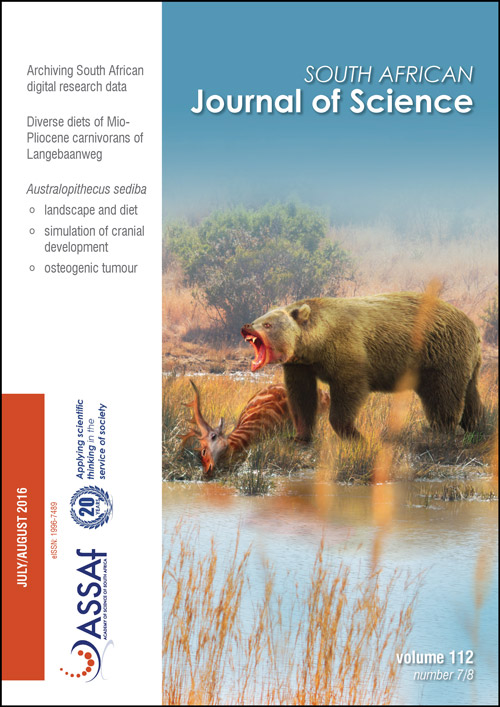Diverse diets of the Mio-Pliocene carnivorans of Langebaanweg, South Africa
DOI:
https://doi.org/10.17159/sajs.2016/20150480Keywords:
Carnivora, Agriotherium, Hayeanidae, Felidae, palaeodiet reconstructionAbstract
The Mio-Pliocene guild of carnivorans of Langebaanweg (LBW), South Africa, is phylogenetically and ecologically diverse. Unlike modern African fauna, this fossil sample contains a large ursid; although there are mustelids, herpestids and viverrids in Africa today, some of the LBW members of those families were much larger than their modern confamilials. There were also numerous felid species, including some that possess a more sabretoothed dental morphology, as well as several species of hyaenids that were very different from their modern confamilials. Questions remain about the dietary morphospace occupied by these fossils. Which taxa were predominately durophagous and which were the most hypercarnivorous? Did the level of durophagy and hypercarnivory in the LBW taxa reach the level of specialisation found in modern carnivores? In the current study, we evaluate the dietary specialisations of all the large terrestrial LBW carnivorans through analysis of the radii-of-curvature and intercuspid notches present in the mandibular dentition. We found that the LBW carnivorans had less sharp premolars than do their modern confamilials – an indication of greater durophagy. However, some families contain individuals with more extreme intercuspid notch patterns, indicating greater hypercarnivory. The ursid also possessed a suite of morphology unlike any modern carnivoran, exhibiting some morphology conducive to durophagy and some that places it functionally among the most hypercarnivorous of modern carnivorans. Thus it was likely capable of consuming high levels of both flesh and bone.
Published
Issue
Section
License

All articles are published under a Creative Commons Attribution 4.0 International Licence
Copyright is retained by the authors. Readers are welcome to reproduce, share and adapt the content without permission provided the source is attributed.
Disclaimer: The publisher and editors accept no responsibility for statements made by the authors
How to Cite
- Abstract 592
- PDF 633
- EPUB 205
- XML 246












.png)